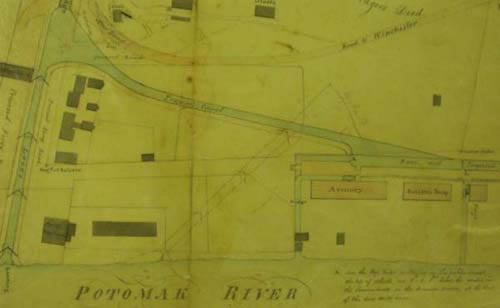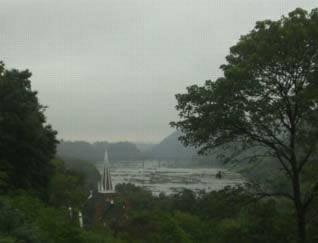
An
early (1803) plan for the armory buildings at Harpers Ferry.
In this version, it appears that the skriting canal along the Shenandoah
was to empty directly into the Potomac.
Detail of map in the National Archives.
|
To be added
Mile
60.2:
The
canal company continued to harbor hopes of a dam at this location, suggesting
in its 1837 stockholder?s report that the Armory dam would be insufficient
to supply its both own works and the canal. In one of its more extreme
fits of wishful thinking, the company supposed that the federal government
?aware of the necessity of having the undivided use and control of the
upper dam as a feeder, will erect one for the purpose of the company,
at the point designated, below the mouth of the Shenandoah.?
|

The
view from "Jefferson's Rock" at Harper's Ferry.
Photo by author, August 2002
|
Additional Notes
Jefferson's
famous description of the scene at Harper's Ferry:
Jefferson's
description of Harper's Ferry appeared in his Notes on the State
of Virginia, which he first published in Paris in 1785. Jefferson
stated that most of the book was compiled in 1781 and 1782 in response
to a list of queries from the Secretary of the French Legation in American,
Marquis Francais de Barbe-Marbois, a time-frame that predates his first
visit to Harpers Ferry. Therefore, the passage on Harper's Ferry was
a later interpolation.
In a letter
to Horatio Spafford on May 14, 1809, in which he responded to suggestions
that he had not actually seen Harper's Ferry when he wrote his Notes,
Jefferson stated that his description had been inspired by a visit to
Harper's Ferry in October of 1783. While Jefferson's memory in later
years was prone to play him false, this is substantiated by payments
noted in his memorandum book, which places him at Harper's Ferry on
October 25. On that occasion, he was travelling to Philadelphia as a
Virginia delegate to the Continental Congress, accompanied by his elder
daughter Patsy in his two-horse phaeton.
Jefferson's
reference to the scene being "worth a journey across the Atlantic"
is interesting because he had not yet gone abroad when he viewed Harper's
Ferry in 1783, though the prospect of a sea-voyage was certainly on
his mind. The Continental Congress had appointed him one of the commissioners
to negotiate with the British in the winter of 1782-83, shortly after
his wife's death, but his trip to Paris was forestalled by bad weather
and the threat of capture by British warships. Jefferson did not begin
his first voyage across the Atlantic until July of 1784, arriving (with
daughter Patsy) in Paris in early August.
Seen in
this context, Jefferson's description of Harper's Ferry, probably penned
on the other side of the Atlantic, evinces a certain degree of homesickness.
|
|
Adams'
visit to Harper's Ferry:
John
Quincy Adams and other dignitaries and canal company officials travelled
up the newly-opened C&O Canal to Harpers Ferry in May of 1834 and
took a tour of the town, including the Armory. Adams, at the time a
Senator from Massachusetts, might have been biased against the Harpers
Ferry Armory as a rival to the Springfield Armory. However, his assessment
of the inferiority of the works at Harpers Ferry was accurate, and he
knew from his term as President that the Armory at Harper's Ferry had
experienced management problems for most of its existence.
Adams
also offered an interesting counterpoint to Jefferson's famous panegyric
on the natural beauty of the confluence of the Shenandoah and Potomac
Rivers at Harper's Ferry. The former president's deferential references
to "Mr. Jefferson" are interesting, as he had long been acquainted
with the legendary Virginian, first meeting him when Jefferson was an
emissary to France and John Quincy was a precocious youth in Paris accompanying
his father. His comments show that he was not overawed by the Sage of
Monticello, and his comments on the view perhaps also reflect some residual
animosity from a lengthy and bitter feud between Jefferson and his father
that sprang from the election campaigns of 1796 and 1800.
|
Documents
John
Quincy Adams' account of his visit to Harper's Ferry by canal-boat,
and impressions of the view from Jefferson's Rock:
May 23 -- I was up this morning before five o'clock, and my
son John went with me over to Georgetown, to the landing-place of
the Cheseapeake and Ohio Canal. There we found two canal-boats, one
of them of cast-iron. They were filled with a company chiefly of members
of Congress, and a few of them had their families with them; all invited
by the President and Directors of the Cheseapeake and Ohio Canal Company
to make an excursion to Harper's Ferry. My son left me at the landing-place
and returned home. I entered the largest of the two boats, which was
full of company, among whom a small number of ladies. The band of
music of the Marine Corps were also there, distributed in the two
boats. Mr. Charles F. Mercer, late President of the Corporation, and
the real founder of the whole undertaking, was of the company. John
P. Van Ness, Mayor of Washington, Mr. Coxe, of Georgetown, and Colonel
Abert, a Director on the part of the Government, did the honors of
the party.
The passage on the canal was very slow, and continually obstructed
by the stoppage of the locks. Of these there are thirty-four between
Georgetown and Harper's Ferry. There was a light collation and dinner,
and, after it, some drinking of strong wine, which made some of the
company loquacious and some drowsy. The band gave occasional reports
of animating instrumental music. The canal almost the whole way follows
close upon the course of the Potomac River; the country along the
margin of which is generally beautiful, sometimes wild, and in other
parts variously cultivated, but seemingly little inhabited. There
is not a luxuriously comfortable country-seat on the whole way, nor
one that bespeaks affluence and taste.
Harper's Ferry, May 24 -- At one o'clock we all dined together
at the inn, and after dinner first visited the armory, where the rifles
are made, but the works are not comparable to those at Springfield.
We then ascended the hill which overlooks the college, and rested
at the residence of Captain John P. Hall. There we saw the junction
of the Potomac and Shenandoah Rivers, described somewhat enthusiastically
by Mr. Jefferson. I went to the hanging rock, that bears his name,
and observed the double range of precipitous rocky hills between which
the river flows. It has some resemblance, on a smaller scale, to the
course of the Elbe between Dresden and the borders of Bohemia. There
is not much of the sublime in the scene, and those who first see it
after reading Mr. Jefferson's description are usually disappointed.
|
|
Porte
Crayon's description of the scenery at Harper's Ferry,
from his 1858 railroad excursion:
Harper's Ferry is situated on a point of land at the confluence of
the Potomac and Shenandoah rivers, and opposite the gap in the Blue
Ridge through which the united streams pass onward to the sea. The
fact that it is the seat of a national armory, and has been described
in glowing language by Jefferson, may have given it a wider notoriety
than the comparative merits of its scenery would justify; and the
tourist who only gives it a passing glance may experience a feeling
of disappointment. But if, instead of four hours, he should be fortunate
enough to have four days at his disposal, or even four weeks, to pass
in exploring the town and its environs, he can be no true lover of
the sublime, romantic, and beautiful, if he fails to acknowledge that
his time has been well spent, and that Harper's Ferry has justified
her ancient renown.
|
|
Sources:
-
Diary
text from The Memoirs of John Quincy Adams, Comprising Portions
of His Diary from 1795 to 1848, as transcribed by Charles Francis
Adams (Volume 8), also included in a single-volume selection edited
by Allan Nevins.
-
-
Notes
on the State of Virginia, Thomas Jefferson, published in 1787
in New York.
- Diary
of My Travels in America, Louis Philippe, King of France, 1830-1848,
Translated by Stephen Becker, published by Delacorte Press, New York,
NY, 1977. [Translated from Journal de Mon Voyage d'Amerique,
published by Librairie Ernest Flammarion in 1976--includes a brief
impression of the scenery at Harper's Ferry as it was in 1797.]
- A
Tour Through Part of Virginia in the Summer of 1808, by John Edwards
Caldwell, originally published in Belfast, Ireland, 1810, edited by
William M. E. Rachel and republished by the Dietz Press, Inc., Richmond,
Virginia, 1951. [The letter dated June 11, 1808, from Harper's Ferry,
includes a rare description of the batteau trade on the Potomac.]
-
Jefferson's
Memorandum Books, Accounts with Legal Records and Miscellany, 1767-1826,
Volume 1, edited by James A. Bear, Jr. and Lucia C. Stanton, Princeton
University Press, Princeton, NJ. [See page 537]
-
Harpers
Ferry Armory and the New Technology: The Challenge of Change,
Merritt Roe Smith, Cornell
University Press, Ithaca, New York, 1977
-
-
"John
H. Hall, Virginia Gunmaker," by Philip R. Smith, Jr., in Virginia
Cavalcade, Library of Virginia, Richmond, Virginia, Spring 1962.
[Sadly, Virginia Cavalcade, published for 51 years by the Library
of Virginia, has been cancelled as a part of massive State funding
cutbacks in the Fall of 2002.]
-
Date
of March 1, 1761 given for licensing of a ferry "... from the
land of Robert Harper, in the county of Frederick, over Potowmack
river, to his land on the opposite side, in the province of Maryland,
the price for a man, three pence three farthings, and for a horse
the same ...", from Statutes-at-Large of Virginia, compiled
by William Waller Hening for the General Assembly and printed as
a multi-volume series from 1819-1823.
Also
on the Web:
-
Edward
Beyer's Album of Virginia
(drawings from his travels in 1857, published in 1858) on the Valley
of the Shadow Web site includes two handsome illustrations of
Harper's Ferry, one of the Armory and the railroad bridge, and the
other a somewhat enhanced "view from Jefferson's Rock."
-
The
John Brown page on the Valley of the Shadow Web site includes
transcriptions of eyewitness
accounts of the Harper's Ferry raid by Charles White, a minister
visiting the town at the time of the raid, and Alexander Botelor,
who owned Botelor's Mill near Shepherdstown.
-
The
Library of Congress also has John Brown page for October
16 in its "Today in History" series.
- See
the Harpers Ferry National
Historical Park Web site for an extensive on-line collection of
historical photographs.
|


